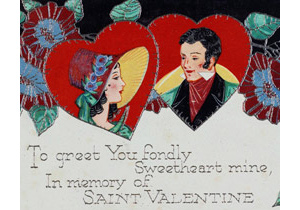The history of Valentine's Day
Yes, we know, February 14 means hearts, red roses and chocolates. But how did the celebration originate? By Adrienne Wyper

If you're lucky enough to hear the plop of a Valentine hitting the doormat, it may surprise you to know that our celebration on February 14 has more to do with a wolf than a saint. Although St Valentine is now known as the patron saint of lovers, this Roman priest was imprisoned and then martyred in 269 AD for helping persecuted Christians.
The present-day practice of anonymously asking a member of the opposite sex to be your lover has its roots in a popular pagan ritual, where boys selected girls to be their partners by drawing their names out of an urn.
This Roman festival, called Lupercalia, celebrated the day when the she-wolf suckled Romulus and Remus, founders of the city of Rome. The festival was borrowed by the early Christian church and moved back one day to coincide with an existing saint's day.
Another theory behind the custom of choosing a lover on this day, also originating from the animal kingdom, is the old belief that this was when birds chose their mates for the following year.
The earliest known Valentine's Day message was sent in the form of a letter from Margery Brews to John Paston, 'my right belovyd Valuntyn', in 1477, following a dispute about the size of her dowry.
Valentine's cards as we know and love them today, weren't introduced until around 1834, when Jonathan King of London perfected a method of manufacturing paper lace on a commercial scale. His wife had the bright idea of scattering feathers and pieces of coloured paper over the cards.
Also popular at this time and throughout the Victorian era were 'vinegar Valentines' or 'penny dreadfuls'. These were sent on Valentine's Day to unpopular people. To add insult to injury, in those days you had to pay to receive one, as postal costs were paid by the recipient, not the sender!
For those who left everything to the last minute, a special Valentine' Day telegram was issued in 1936. Fifty thousand were sent, including one with the message: 'And now I've asked you to be nine/By gosh! It's cost me eight and nine!' Bet that boosted the romance in that relationship.
And why hearts? They're perceived as the seat of our emotions. And red roses? In the language of flowers, these symbolise true love.










